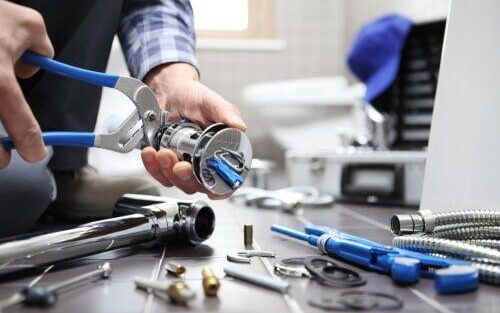When a simple repair will not solve the plumbing problems in your home it may be time to have your house repiped. Repiping your house may be a large undertaking, but you do not need to feel overwhelmed. In this guide, we review the whole process. So, you can see if you need to repipe, to getting the right plumber and the pipe materials you must consider for the project.
When Is There a Need To Repipe Your House?
Taking on the task to repipe a house will be a serious undertaking. It will involve a sizable investment of both money and time. In some instances, old pipes can be replaced and so you may be able to avoid repiping the whole house. So, you will have to decide if there are reasons to repipe your house. What are some of the reasons to make you decide on repiping your house?
Are you always paying for plumbing repair work?
If you are constantly paying to fix problems with the plumbing in your home, it may be time to repipe. A new pipe system can serve to get rid of recurring plumbing problems. Replacing the whole network with a new system will help avoid having to do those constant repairs for a long time. It can also allow you to save money in the long run. The cost of new piping will be less than what you will spend over the years on repairs. You will save the money spent on repairs.
Your plumbing was done with lead pipes.
Is your house more than a hundred years old? If so, there is the likelihood that pipes made of lead are in the plumbing. It is also likely that the piping was changed. But there are still some houses with lead pipes. The presence of lead is a serious health risk to occupants of the home. So, if you determine that the pipes in your home are of lead, then the only safe thing to do is repipe.
Galvanized steel pipes used for your plumbing.
Galvanized steel pipes were used in homes before the 1940s. These galvanized pipes corrode after several years. When corrosion builds up in these pipes, it restricts the flow of water. The sediment from the corrosion can also contaminate your drinking water.
Remodeling your home can be another reason to repipe.
When you decide on doing a new bathroom or changing other plumbing fixtures in your home, doing a repipe at the same time would be a good idea. A repiping can save you time and money. It may also help you to avoid issues that can arise from the meeting of the old and new systems.
What repiping your house entails
Repiping your whole house will be an extensive project. It would involve you having to replace hot and cold-water pipes. You will also replace wastewater drainage pipes. Many homeowners will find that repiping a home is one of the largest renovations they will ever have to do. As a homeowner, you should know how to repipe your house.
Before You start
The first stage in the repiping project is to get an inspection done and an estimate prepared. You can get several plumbing companies to do an estimate for you so you can select the best offer to do your project. Many plumbing companies will do a free estimate for a full repipe of your home. They will also help you decide if you should do a simple repair, or a partial repipe, or do a full repipe of your house.
If you decide to go with a whole house repiping, the plumber may need a work permit from the local authorities. Those doing the repiping will help you choose the best materials for your repiping.
Starting the Work
You must ensure you cover your furniture and other possessions for protection. During the work, your water service will be shut off. The plumber should be able to work so that the water will be shut off for a short a period as possible during the day. So you have the least water supply disruption.
Plumbers have tools to help them get the location of pipes behind walls. They cut into your drywall to get access to those pipes. After installing the new pipes, they will patch and repaint the drywall. They will restore it to its original state.
How Long will Repiping Take?
Repiping a house can take from a few days to a week. Smaller houses can be repiped in as little as two days. Larger homes with several bathrooms can take a lot longer. But you will not lose your plumbing for all that time. You can use your old system while the new system is being built alongside the old existing pipes.
You will only be without water when the plumber is making the changeover from the old to the new system.
What to expect to pay for Repiping a House?
The cost of repiping a house varies depending on several factors. A repiping project can cost from $1500 to $15000. The cost can depend on the size of your house and its plumbing network and the kind of pipes installed. The cost of building permits should be added if they are required.
Removing the older pipes from the walls is also a factor to consider in the cost. Many homeowners decide to leave the old, pipes in the walls. Some may want to have them removed. It will be an added cost to have the plumbing company take out the old pipes.
Cost of pipes
Copper pipes will cost the most. These pipes cost around $1-$3 per foot. Also, you need to bear in mind that copper is a traded commodity, so the price can change daily. CPVC pipes are a cheaper alternative to copper and are the preferred type most times. Costs for this type of piping start at about $0.40 per foot. PEX pipes are the newest type of pipes for plumbing in the home. These pipes are cheaper than CPVC pipes. You can buy PEX pipes for as low as $0.30 per foot.
Getting the Right Plumber
repiping is a major undertaking, so it is important to get the right plumber for the job. With the wrong person, you can end up with someone cutting corners. That will cost you more. To avoid problems, you will need to look for a plumber or a plumbing company that satisfies some basic conditions.
The things you should look for should include:
- Licensed and insured.
- Good online references and reviews.
- Many years of experience in the business
- A full, and detailed estimate. It should include labor and material costs, and other expenses.
- A guarantee for the work to be done.
Know your pipes
A major decision you and your plumber will have to make before you move on with repiping your house is the kind of material to use. You have three choices – copper, CPVC, and PEX. Each of these has its advantages and disadvantages. Also, a plumber may have his preference and recommend it for your project. So, an understanding of each type of pipe will help you make the right choice.
Pros and cons of using each type.
Copper pipes
Copper pipes have been in use for decades and are the oldest type of piping in use. Many plumbers and builders prefer copper pipes. They are more durable than PEX and will not corrode like steel pipes. It gives you the best plumbing system and not likely to contaminate your water supply.
A copper plumbing system can last 75 to100 years. It is resistant to earthquake shocks. But the industry trend lately has been toward the use of CPVC and PEX. They are alternatives in remodels and new constructions.
This trend may be due to some disadvantages which include relative cost. Copper is more expensive. And the price changes often since it is a traded commodity. Installation of copper pipes also requires more work.
CPVC (Chlorinated polyvinyl chloride) Pipes
CPVC pipes are the common choice for remodels and repiping. These pipes came on the market in the 1960s and since then have been gaining popularity. These pipes are easier to install than copper pipes. They are also suited for existing buildings. They are not as long-lasting as copper pipes but should last at least 50 years.
CPVC is cheaper than copper and safe for drinking water. It can be used for hot water and is resistant to acid and other chemicals. But it can crack in earthquakes, so it is not suited for earthquake-prone areas.
PEX (Cross-linked polyethylene) Pipes
PEX is the latest piping material to enter the market. Its use started in new European construction before use in the United States started in the late ’90s. PEX is versatile, flexible, and easy to work with because of these qualities. These features, make it a favorite among modern builders.
But PEX is new, and it is not known how long a PEX system will last. It is more cost-effective than copper pipes. Its flexibility makes installation easy and removes the need for joint fittings. There are other pros, but it is not as durable as copper and will degrade in 30 days with exposure to sunlight.
Other Plumbing Upgrades to consider
Have plans for other plumbing upgrades? Do them with your repiping. You will save time and money with much of the prep already done for the repiping. Upgrades to consider can include low-flow fixtures, a tankless water heater, and smart water shutoff.
Low-Flow Fixtures
Repiping is a good time to give your home low-flow fixtures. With showerheads, faucets, and toilets using less water, your home’s value will increase. You will also have a lower water bill.
Tankless Water Heater
This would have a longer life, take less space than regular water heaters, and give you hot water nonstop.
Smart Water Shutoff
A smart water shutoff would be a good upgrade if you are repiping to change old and leaking pipes to cut out water waste.
Conclusion
You have seen what is involved in how to repipe your house and understand the process and the materials to be used. It should now be easy to make the right decisions if you must repipe your home. It is a large investment to repiping, but your plumbing will be reliable and last for a long time.


